CRITICAL ANALYSIS OF SELF-SUPERVISION: Difference between revisions
| Line 52: | Line 52: | ||
[[File:critical_analysis.png|500px|center]] | [[File:critical_analysis.png|500px|center]] | ||
The above table (Table3) corresponds to the Accuracy of linear classifiers on different network layers. | The above table (Table3) corresponds to the Accuracy of linear classifiers on different network layers on CIFAR10 and CIFAR100 datasets. | ||
== Source Code == | == Source Code == | ||
Revision as of 19:07, 6 December 2020
Presented by
Maral Rasoolijaberi
Introduction
This paper evaluated the performance of the state-of-the-art self-supervised methods on learning weights of convolutional neural networks (CNNs) and on a per-layer basis. They were motivated by the fact that low-level features in the first layers of networks may not require the high-level semantic information captured by manual labels. This paper also aims to figure out whether current self-supervision techniques can learn deep features from only one image.
The main goal of self-supervised learning is to take advantage of a vast amount of unlabeled data to train CNNs and find a generalized image representation. In self-supervised learning, unlabeled data generate ground truth labels per se by pretext tasks such as the Jigsaw puzzle task[6], and the rotation estimation[3]. For example, in the rotation task, we have a picture of a bird without the label "bird". We rotate the bird image by 90 degrees clockwise and the CNN is trained in a way to find the rotation axis, as can be seen in the figure below.
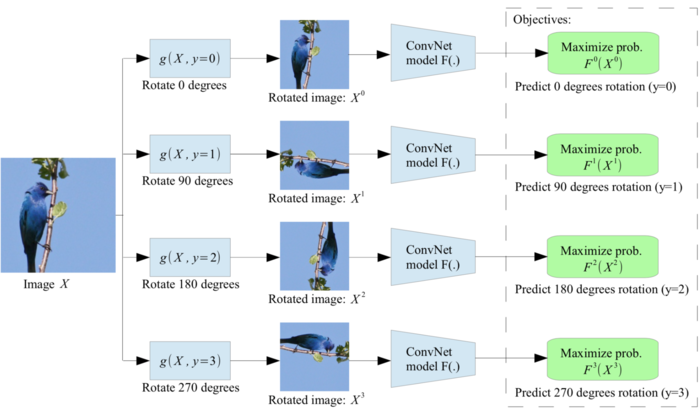
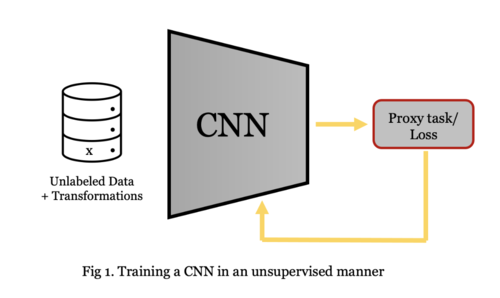
Previous Work
In recent literature, several papers addressed self-supervised learning methods.
- Generative models: Generative Adversarial Networks (GANs), learn to generate images in an adversarial manner. They consist of a generator network which maps noise samples to image samples and a discriminator network whose task is to distinguish the fake images from the real ones. These two are trained together until the point where the fake images are indistinguishable. BiGAN [2], or Bidirectional GAN, is simply a generative adversarial network plus an encoder. The generator maps latent samples to generated data and the encoder performs as the opposite of the generator. After training BiGAN, the encoder has learned to generate a rich image representation.
- In RotNet method [3], images are rotated and the CNN learns to figure out the direction. Therefore, this task is a 4-way classification task. Most images are taken upright which could be considered as labeled images with label 90 degrees. The authors of RotNet argue that the concept of 'upright' is hard to understand and requires high-level knowledge about the image, so this task encourages the network to discover more complex information about the images.
- DeepCluster [4] alternates between k-means clustering step, in which pseudo-labels are assigned to the data by k-means on the PCA-reduced features, and the learning step in which the model tries to learn to fit the representation to these labels(cluster IDs) under several image transformations. These transformations include random resized crops with [math]\displaystyle{ \beta = 0.08 }[/math] and [math]\displaystyle{ \gamma = \frac{3}{4} }[/math] and horizontal flips.
- In Jigsaw task [6], the unlabelled images are divided into nine patches and then, the patches are permuted randomly to create a new image. Then, a deep neural network is trained to predict the permutation of patches in the perturbed image.
Following is the work done in the domain of learning from a single image:
- Rodriguez et al. [7] used max-margin correlation filters to learn robust tracking templates from a single sample of the patch.
- Malisiewicz et al. [8] used a semi-parametric exemplar SVM model where the model uses one positive sample and separates it from thousands of negative samples mined from the background.
Method & Experiment
In this paper, BiGAN, RotNet, and DeepCluster are employed for training AlexNet in a self-supervised manner. To evaluate the impact of the size of the training set, they have compared the results of a million images in the ImageNet dataset with a million augmented images generated from only one single image. Various data augmentation methods including cropping, rotation, scaling, contrast changes, and adding noise, have been used to generate the mentioned artificial dataset from one image. Augmentation can be seen as imposing a prior on how we expect the manifold of natural images to look like. When training with very few images, these priors become more important since the model cannot extract them directly from data.
To measure the quality of deep features on a per-layer basis, a linear classifier is trained on top of each convolutional layer of AlexNet. Linear classifier probes are commonly used to monitor the features at every layer of a CNN and are trained entirely independently of the CNN itself [5]. Note that the main purpose of CNNs is to reach a linearly discriminable representation for images. Accordingly, the linear probing technique aims to evaluate the training of each layer of a CNN and inspect how much information each of the layers learned. The same experiment has been done using the CIFAR10/100 dataset.
Quantitative Analysis
They compared the learned filters of all first-layer convolutions of an AlexNet trained with the different methods and a single image. Showed how the results of retraining a network with the first two convolutional filters, or the scattering transform from (Oyallon et al., 2017), left frozen. They also observed that their single image trained DeepCluster and BiGAN models achieve performances closes to the supervised benchmark. Lastly, they show how their features trained on only a single image can be used for other applications.
Results
Figure 2 shows how well representations at each level are linearly separable. Ttable1 indicated the classification accuracy of the linear classifier trained on the top of each convolutional layer. According to the results, training the CNN with self-supervision methods can match the performance of fully supervised learning in the first two convolutional layers. It must be pointed out that only one single image with massive augmentation is utilized in this experiment.
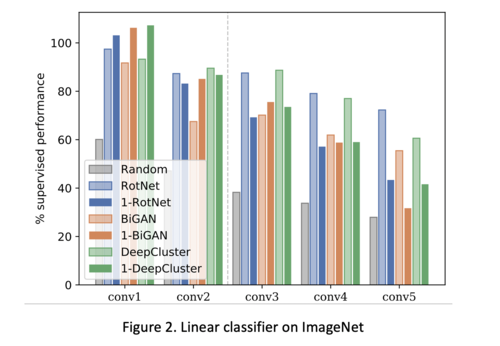
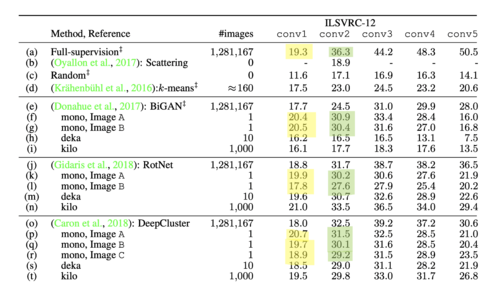
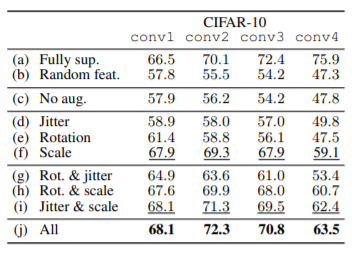

The above table (Table3) corresponds to the Accuracy of linear classifiers on different network layers on CIFAR10 and CIFAR100 datasets.
Source Code
The source code for the paper can be found here: https://github.com/yukimasano/linear-probes
Conclusion
In this paper, the authors conducted interesting experiments to show that the first few layers of CNNs contain only limited information for analyzing natural images. They saw this by examining the weights of the early layers in cases where they only trained using only a single image with much data augmentation. Specifically, sufficient data augmentation was enough to make up for a lack of data in early CNN layers. However, this technique was not able to elicit proper learning in deeper CNN layers. In fact, even millions of images were not enough to elicit proper learning without supervision. Accordingly, current unsupervised learning is only about augmentation, and we probably do not use the capacity of a million images, yet.
Critique
This is a well-written paper. However, as the main contribution of the paper is experimental, I expected a more in-depth analysis. For example, it is interesting to see how these results change if we change AlexNet with a more powerful CNN like EfficientNet? Also, the authors could try other types of Self-Supervised tasks such as jigsaw task and state-of-the-art PIRL [8].
References
[1] Y. Asano, C. Rupprecht, and A. Vedaldi, “A critical analysis of self-supervision, or what we can learn from a single image,” in International Conference on Learning Representations, 2019
[2] J. Donahue, P. Kr ̈ahenb ̈uhl, and T. Darrell, “Adversarial feature learning,”arXiv preprint arXiv:1605.09782, 2016.
[3] S. Gidaris, P. Singh, and N. Komodakis, “Unsupervised representation learning by predicting image rotations,”arXiv preprintarXiv:1803.07728, 2018
[4] M. Caron, P. Bojanowski, A. Joulin, and M. Douze, “Deep clustering for unsupervised learning of visual features,” in Proceedings of the European Conference on Computer Vision (ECCV), 2018, pp. 132–149
[5] G. Alain and Y. Bengio, “Understanding intermediate layers using linear classifier probes,”arXiv preprint arXiv:1610.01644, 2016.
[6] Mehdi Noroozi and Paolo Favaro. Unsupervised learning of visual representations by solving jigsaw puzzles. In ECCV, 2016.
[7] T. Malisiewicz, A. Gupta, and A. A. Efros. Ensemble of exemplar-SVMs for object detection and beyond. In Proc. ICCV, 2011.
[8] A. Rodriguez, V. Naresh Boddeti, BVK V. Kumar, and A. Mahalanobis. Maximum margin correlation filter: A new approach for localization and classification. IEEE Transactions on Image Processing, 22(2):631–643, 2013
[9] I. Misra and L. van der Maaten, "Self-Supervised Learning of Pretext-Invariant Representations," 2020 IEEE/CVF Conference on Computer Vision and Pattern Recognition (CVPR), 2020.